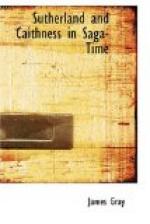In support of Johanna’s title it is to be observed that neither Magnus II, nor his wife, is recorded to have claimed any part of the Strathnaver lands, a fact which indicates that Johanna and her predecessors had acquired an independent title to them, and that, too, a title not derived through Earl John. Again, (though in a time when records fail us, the argument proves little) Johanna, although from her probable date she might have been so, is not recorded to have been a daughter of John. Further, to be of suitable age[21] to marry Freskin she must have been born long after any known child of Earl John, even his son Harald who had died in 1226. Lastly, neither Johanna nor her husband Freskin nor any descendant of hers ever claimed either the whole of or any share in the Orkney jarldom,[22] which Earls Harald Maddadson, David and John had held in its entirety, and to which Johanna, had she been Earl John’s only daughter, or her husband Freskin would have been entitled to claim to succeed as sole heir; while if John had had two daughters, and Johanna had been one of them, she or her husband Freskin would have been entitled to claim a grant of some share at least of the lands appertaining to the Orkney jarldom.
It was, however, Earl Magnus who made such claims, and with success, and he may well have obtained the Orkney jarldom and lands, and part of the Caithness earldom as well, with the title, not only as being the son of the elder of Harald Ungi’s sisters, but as the husband of Earl John’s nameless daughter, while his name of Magnus, afterwards so often repeated in the Angus line, came into that line obviously through his mother at his baptism, and not through his wife at his marriage.
The name of Johanna, on which Skene mainly founds his assertion that Johanna of Strathnaver was Earl John’s daughter, is just as easily explicable, and with equal verisimilitude, if she was not. Snaekoll went to Norway in 1232, leaving behind him, on our hypothesis, one child, an infant daughter of tender years, or possibly as yet unborn. The child of a younger child of Ragnhild would probably be still younger. Heiress to very large landed estates and justly entitled to claim a moiety of the Erlend Thorfinnson half of Caithness and all the Moddan territories, this child would be made by the king of Scotland a ward, to be married, if female, in due course to a suitable husband. The Queen of Scotland, who in 1232 had been childless for eleven years and never had any children afterwards, was an English princess who was married to Alexander II on 19th June 1221, and lived till 4th March 1237-8, a period which would cover all Johanna’s early years. The queen’s name was Joanna, and Johanna of Strathnaver may have been called after her, as Earl John had possibly been called after her father King John of England, the friend of Earl John’s father, Harold Maddadson.
We now have to fix the date of Freskin de Moravia, nephew of William, dominus Sutherlandiae since about 1214. Freskin, as stated, was undoubtedly the husband of Johanna of Strathnaver, and became on his marriage owner of her lands there as well as of a moiety of the Caithness earldom lands.




